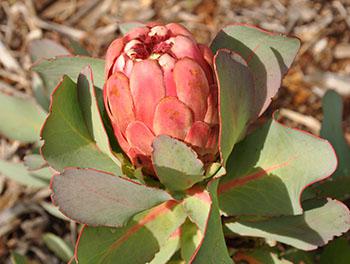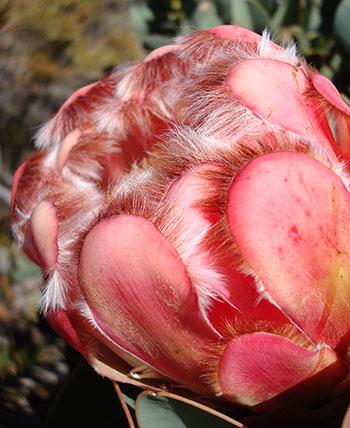Protea grandiceps
Protea grandiceps Tratt.
Family: Proteaceae
Common names: red sugarbush, red protea (Eng.); rooisuikerbos, rooisuikerkan (Afr.)
SA Tree No: 89.2
Introduction
This is a very slow growing fynbos shrub that produces excellent, long lasting, red flowerheads, beautiful for garden display and as a cut flower, and with its broad blue-green leaves, it makes a perfect shrub for the fynbos garden.

Description
Description
Protea grandiceps is an evergreen, compact, rounded shrub that grows about 2 m high and 2–3 m wide, with a single main trunk. Branches are stout, hairless, with brown bark when mature. The leaves are ovate to obovate, 80–130 mm long and 30–85 mm wide, curved, hairless, with rounded tips and a wavy margin, pointing upwards and lightly compact on the new growth, with a single, very visible, primary vein in each leaf. The leaves are blue-green with reddish margins.
This shrub produces broadly oblong flowerheads which are 100–140 mm long and 60–80 mm in diameter. The immature flowerheads are ovate while the involucral bracts are closed, and become oblong as they mature, and the involucral bracts open. It produces attractive flowerheads with brick-red involucral bracts that are heavily bearded with a thick fringe of hairs, about 10–15 mm long; these hairs are shorter on the lower or outer involucral bracts and longer on the upper or inner involucral bracts. The colour of the hairs of the beard ranges from brown to pure white or maroon, depending on where the species is growing naturally. Male and female elements are carried in the same flowers; the female consist of the stigma and pollen presenter, style and ovary, and the male consists of stamens and anthers. The style is about 65–75 mm long positioned inside the cup of involucral bracts, and covered by hairs. The pollen presenter is exposed at the tip of the style. Protea grandiceps begins to flower in spring, from September, and produces flowerheads abundantly until mid-summer, December to January.

The fruits are serotinous (retained on the plant for years) and they take about 7 months to ripen. In the wild, these fruits will remain on the plant for years until the plant dies, or a fire occurs, or if insects consume the seedhead stalk and the water supply to the seedhead stops.
Conservation Status
Status
According to the Red List of South African Plants, Protea grandiceps is assessed as Near Threatened (NT). It occurs in small, severely fragmented subpopulations over a relatively wide area and its population fluctuates. This species is slow to mature and set seed which means that frequent fires could destroy a subpopulation if the time between fires is too short to allow the plants reach maturity and set seed. Other threats are wild flower collecting, over-harvesting of firewood (in the past), hybridization and drought-related mortality. In its wide range of distribution Protea grandiceps almost went extinct on Table Mountain (Tony Rebelo, 2001).
Distribution and habitat
Distribution description
Protea grandiceps is widespread over the centre of the core Cape subregion from the Cape Peninsula and Hottentots-Holland Range to Riviersonderend, Outeniqua, Winterhoek and Kammanassie Mountains. Protea grandiceps grows on dry sandstone slopes, occasionally moist, and is often found on peaks and steep rocky slopes where they are relatively safe from fires.

Derivation of name and historical aspects
History
The genus Protea was named by Carl Linnaeus, the father of taxonomy, after Proteus the mythological Greek god who could see into the future and always spoke the truth. However, to be able to extract a prophecy, one had to grasp him while he changed into numerous animate or inanimate forms. Grandiceps means ‘large or noble head’, from the Latin word grandis, meaning ‘great or large’ and ceps meaning ‘headed’.
The Proteaceae is a family of one magnificent flowering plant after another. It comprises of more than 1 700 species and 80 genera. Most of the about 800 species and 45 genera are native to Australia. Africa has about 400 species of which 352 species occur in South Africa, mainly in the winter-rainfall area of the southwestern Cape. Other species occur in Central and South America, island east of New Guinea, New Caledonia, Madagascar, Southeast Asia, New Guinea and New Zealand.
Ecology
Ecology
Most proteas are pollinated by nectar-feeding birds and mostly the visitors are sunbirds and sugarbirds. Protea grandiceps produces pinkish red flowerheads that have no scent, that attract the birds by their colour, as birds do not rely on smell. Protea beetles (Trichostetha fascicularis) and other Scarabaeidae are also important pollinators of protea flowers. Sugarbirds are dependent on proteas, pagodas and pincushions for food.
Proteas are serotinous; when a protea plant dies or is killed by fire, the retained seedheads open to release the seeds, which fall or are blown from the plant. The seeds lie on the ground and become available as food for rodents and birds until they germinate after the winter rain. The seeds of Protea grandiceps are covered in long hairs that aid dispersal by wind, help anchor the seed to the soil and channel moisture towards the seed.
The leaves are sclerophyllous, blue-green in colour and are covered with a fine waxy bloom, all of which helps to prevent the loss of water during the dry, hot and windy summer season.
This protea is killed by fire and will not resprout. Its adaptation to survive fire is to produce masses of seeds, known as ‘reseeding’. In its natural habitat, Protea grandiceps is often seen growing on steep slopes and rocky outcrops, where it is relatively safe from fires.
The proteoid roots of proteas, which form a dense mat not far from the soil surface, and have a surface area fifteen times that of non-proteoid roots, absorb the tiny amounts of nutrients available from the very nutrient-poor soils of the Cape mountains.

Uses
Use
Protea gandicpeps has long lasting cutflowers and is cultivated for the cutflower market, and the wood was used for firewood in the past. Protea grandiceps is an excellent shrub for a fynbos garden and can be planted with most fynbos shrubs, including Paranomus reflexus, species of Syncarpha, Erica discolor, Elegia equisetacea and Leucospermum reflexum.
Growing Protea grandiceps
Grow
Protea grandiceps is a very slow-growing shrub which requires full sun in well drained, acidic soil (between 5–7 pH levels), with moderate watering throughout the year. It can live for up to 20 years or more. It is moderately frost hardy and will tolerate short periods of frost. Protea grandiceps is a water-wise shrub once it is established in the garden, normally 3 years after being planted in the garden. Protea grandiceps is adapted to nutrient-poor soil where phosphorus is scarce. Apply moderate amounts of organic fertilizer to encourage the sensitive proteoid root. Avoid using strong artificial fertilizers containing phosphorus, as they can cause the plants to collapse and eventually die. Keep the soil moist during the hot dry season, by mulching your bed with a layer about 5 mm thick. The mulch will keep the roots cool, keep moisture in the soil and reduce the growth of weeds. There is no need to prune Protea grandiceps, except to remove dead branches or harvest the cutflowers as the shrub naturally grows in a rounded shape.
Protea grandiceps is easily propagated and responds best when propagated by seed. Sow the seed in autumn (March to May) in a well-drained sowing medium, such as a mix of coarse sand and finely milled pine bark. It is important to select the fertile seed before sowing, the fertile seeds are plump, whereas the infertile are not. Protea seeds are very sensitive to waterlogging and humidity. Place them on a well-aerated sowing bench and use a free-draining container. Treating the seeds with smoke will improve germination. At Kirstenbosch National Botanical Garden, seed trays are placed in an airtight plastic tent and smoke from burning fynbos is piped in for 30 minutes, the air is then allowed to clear and the seed trays are watered. Smoke extract can also be used, where the seeds are soaked in the smoke extract for 24 hours and sown. Packets of the Kirstenbosch Instant Smoke Seed Primer are available for sale from the Seedroom. Treat your seed with a dusting systemic fungicide containing the active ingredient metalaxyl, to prevent the post emergence seedling infection. The optimum temperature for germination is 5–10°C for night temperature and 15–20°C for day temperature.
After sowing, cover the seed with a light layer of sand to cover any exposed seed. Keep the soil moist and apply a fungicide once a week. To prevent birds and rodents from eating the seeds, cover the benches or trays with a grid. Once the seed has germinated, they will produce the cotyledons, followed by true leaves. The seedlings are ready to be transplanted into small plastic bags or into compartmentalized trays when they have true leaves. Once potted up place them under the shade net for hardening off, particularly under dry and hot conditions. At Kirstenbosch the seedlings are grown under a shade net in the nursery for a period of 1 to 2 years, until they are ready to be planted into the garden. Shade netting reduces the direct sun which can dry out the soil in the plastic bags and can also prevent scorching.
Protea grandiceps is prone to blight infection. To prevent this, provide good air movement around the plants and spray with mancozeb. Protea grandiceps is also susceptible to the root rot fungus, Phytophthora cinnamomi. To prevent this, avoid digging around the base of your plant, or graft Protea grandiceps scions on the Protea hybrid ‘Pink Ice’, a cross between Protea compacta and Protea susannae, which is more resistant to infection. There are other hybrids that can resist Phytophthora and other various pathogens that can also be used.
References
- Brown, N.A.C. & Duncan, G.D. 2006. Grow fynbos plants. Kirstenbosch Gardening Series. South African National Biodiversity Institute, Cape Town.
- Duncan, G., Brown, N. & Nurrish, L. 2013. Grow proteas. Kirstenbosch Gardening Series. South African National Biodiversity Institute, Cape Town.
- Manning, J. & Goldblatt, P. 2012. Plants of the Greater Cape Floristic Region 1: the Core Cape Flora. Strelitzia 29. South African National Biodiversity Institute, Pretoria.
- Matthews, L.J. & Zoe Carter (Artist). 1993. Proteas of the world. Auckland, New Zealand.
- Raimondo, D., Von Staden, L., Foden, W., Victor, J.E., Helme, N.A., Turner, R.C., Kamundi, D.A. & Manyama, P.A. (eds) 2009. Red list of South African plants. Strelitzia 25. South African National Biodiversity Institute, Pretoria.
- Rebelo, T. 2000. Proteas of the Cape Peninsula. Protea Atlas Project. National Botanical Institute, Cape Town.
- Rebelo, A.G. 2001. Proteas. A field guide to the proteas of southern Africa, edn 2. Fernwood Press, Vlaeberg, Cape Town.
- Rourke, J.P. 1982. The proteas of southern Africa. Centaur Publishers, Johannesburg.
Credits
Mashudu Nndanduleni
Kirstenbosch National Botanical Garden
May 2016
Plant Attributes:
Plant Type: Shrub
SA Distribution: Western Cape
Soil type: Sandy
Flowering season: Spring, Early Summer
PH: Acid
Flower colour: Red
Aspect: Full Sun
Gardening skill: Average
Special Features:
Horticultural zones








Rate this article
Article well written and informative
Rate this plant
Is this an interesting plant?
Login to add your Comment
Back to topNot registered yet? Click here to register.